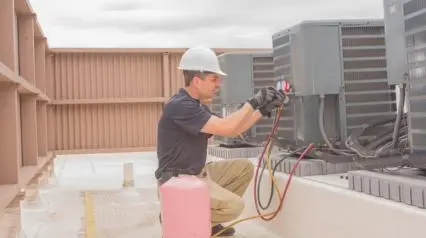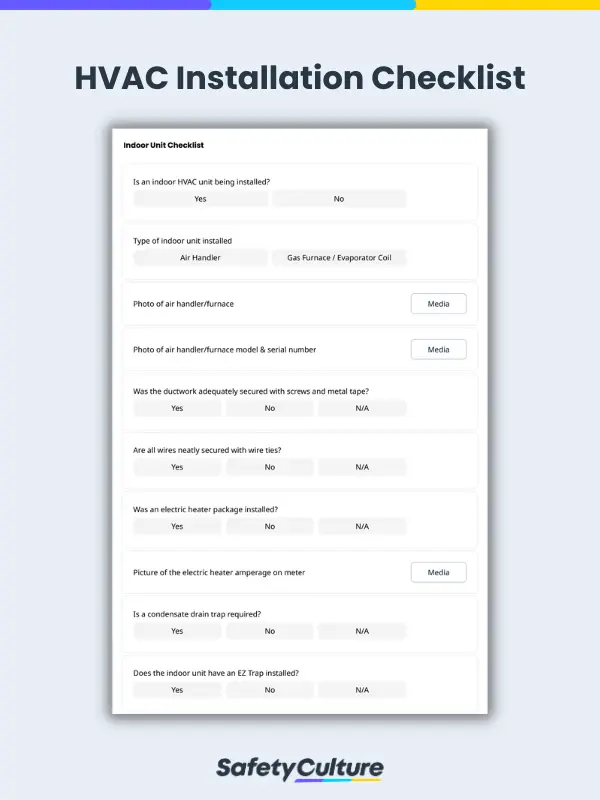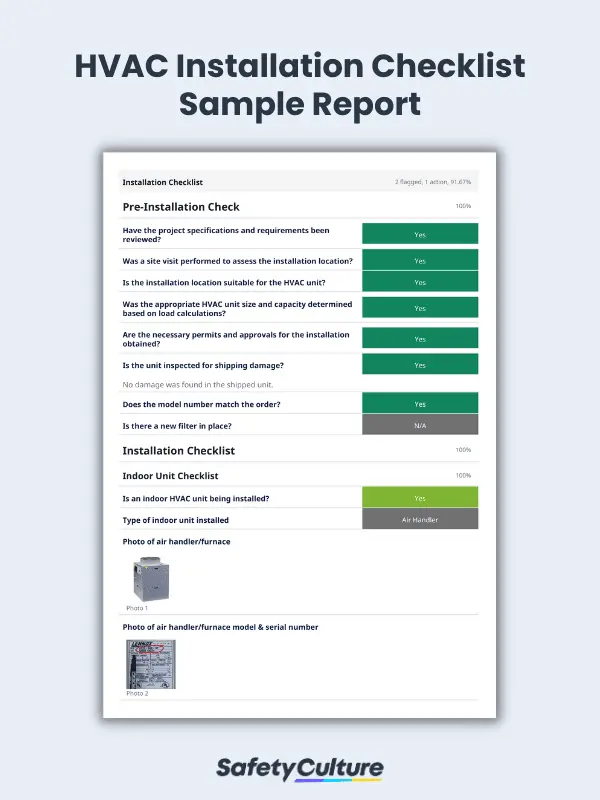What is an HVAC Installation Checklist?
An HVAC (Heating, Ventilation, and Air Conditioning) installation checklist is a document that itemizes all tasks and considerations required when installing an HVAC system. Technicians and contractors can use this checklist to ensure that all necessary steps are taken and that essential factors are accounted for a safe, efficient, and successful installation.
Why Use This Checklist
Checklists are a valuable resource for contractors and technicians when installing HVAC units in homes, establishments, and industrial facilities. Here are 5 great reasons why you should use a checklist for HVAC installations:
1. Completeness
Since the installation process involves multiple steps and components, missed items are bound to happen along the way. Using a checklist helps ensure that all required tasks are carried out, thereby preventing any oversight or omission.
2. Quality Assurance
Checklists also play a crucial role in quality control and assurance. It guides HVAC professionals in performing each step correctly to meet the required specifications. By following the items in the checklist, HVAC installers can consistently uphold quality standards throughout the installation process.
3. Improved Efficiency
In addition, an HVAC installation checklist streamlines the process by giving a clear roadmap for installers. This practice reduces the chances of errors or rework, leading to a more efficient and timely setup of HVAC units.
4. Enhanced Safety
HVAC systems involve electrical connections, gas lines, and other potentially hazardous parts. A checklist allows technicians to follow safety protocols and measures for a safer installation. This lowers the risk of accidents during installation and for the system’s future operation.
5. Compliance with Standards and Regulations
HVAC installations must adhere to specific regulations and industry standards to ensure safety, efficiency, and environmental sustainability. For example, the Air Conditioning Contractors of America (ACCA) sets quality guidelines for residential and commercial HVAC installations.
A checklist can incorporate these requirements into the installation process to meet these standards and avoid potential regulatory issues.
What to Include in an HVAC Installation Checklist
The contents of an HVAC installation checklist may vary depending on the type of unit installed, the setting, and the customer specifications. Generally, it should contain the following sections:
Pre-Installation Tasks
Start the checklist with the items to be reviewed before carrying out the installation process. Consider including the following items in this section:
- Project specifications and requirements
- Site visit and assessment of the installation location
- Size, capacity, and model number of the HVAC unit
- Permits and approvals for the installation
- Condition of the HVAC unit upon shipment
- Information about the new filter (if applicable)
Installation Checklist
The steps outlined in this section can change based on the type of unit for setup. An indoor HVAC system may have different needs compared to an outdoor unit.
Here’s a quick overview of the things to include in this section per HVAC unit type:
Indoor HVAC Unit Installation
- What is the type of indoor unit installed? (e.g., air handler, gas furnace/evaporator coil)
- Was the ductwork adequately secured with screws and metal tape?
- Are all wires neatly secured with wire ties?
- Was an electric heater package installed?
- Is a condensate drain trap required?
- Does the indoor unit have an EZ Trap installed?
- Is the condensate drain line secured with PVC glue?
- What is the filter size?
- Was the new filter installed?
- Was the indoor unit wiped down?
- Were the trash and debris cleaned up?
Outdoor HVAC Unit Installation
- What is the type of outdoor unit? (e.g., air conditioner, heat pump)
- What is the brand of the condenser?
- Was the service disconnect replaced?
- Was the electrical whip replaced?
- What is the outdoor unit amperage draw?
- What is the type of refrigerant used?
- What is the outdoor temperature?
- What is the indoor wet bulb temperature?
- What is the indoor dry bulb temperature?
- What is the charging requirement? (i.e., superheat, subcool)
- What is the required superheat/subcool?
- What is the actual superheat/subcool?
- Are all wires neatly secured with wire ties?
- Is the outdoor unit wiped down?
- Are the trash and particles cleaned up?
Thermostat Installation
- What is the brand of thermostat installed?
- Was the unit in each thermostat mode checked?
- What is the final thermostat temperature and mode?
Customer Communication
Before wrapping up the installation process, the technician should orient the customer on operating and maintaining their newly installed HVAC unit. Here are some guide questions to carry out this process effectively:
- Did the technician allow the customer to see the unit in operation?
- Have the technician conducted a final walkthrough with the client to demonstrate system operation and address any questions?
- After the installation, did the technician discuss the following topics with the customer:
- Thermostat settings
- Warranty information
- Maintenance agreements
- Review request
- Has the technician scheduled follow-up visits for routine maintenance and potential issues?
- Have the technician completed and submitted all required documentation, including permits and inspection reports?
Safety Precautions and Best Practices
During HVAC installations, safety must be a priority to protect both the installers and occupants of the building. Here are some safety precautions and best practices to follow for this process:
- Observe safety guidelines and standards from regulatory and industry bodies, including electrical codes, protective equipment, and proper handling of refrigerants.
- Before starting any work, turn off the power to the HVAC system at the electrical panel to avoid shocks and accidents.
- Use proper lifting techniques for heavy HVAC components, such as motors, units, and ductwork.
- Securely anchor HVAC equipment, especially rooftop units or outdoor condensers, to prevent them from toppling or shifting.
- Maintain adequate ventilation during installation to avoid the buildup of dust, debris, or fumes.
- If working in confined spaces, ensure proper ventilation and monitoring for potentially hazardous gases like carbon monoxide.
- If the HVAC system involves natural gas or propane, exercise caution when working with gas lines.
- Follow proper procedures for leak testing, installation, and connection to prevent hazardous gas leaks.
- Ensure that insulation materials are properly installed, without blocking airflows or coming into contact with heat sources.
- Double-check all electrical connections and ensure they are secure, tight, and properly insulated. Avoid loose connections, exposed wires, or inadequate grounding, as these can lead to electrical shocks or fires.
- Properly label electrical circuits, switches, and control panels to facilitate easy identification during installation, maintenance, or troubleshooting.
- Document any modifications, wiring diagrams, or changes made during the installation process for future reference.
- After completing the installation, verify that safety controls, shutdown features, and emergency procedures are in place and functioning correctly.
FAQs about HVAC Installation
HVAC installations take 1-5 days to complete on average. However, this duration is subject to change based on several factors like the complexity of the HVAC system, the property size, and the number of units to be installed. For instance, small residential units typically require shorter periods while large commercial or industrial installations need more time to finish.
It depends on your local, state, or national regulations for HVAC systems. In many jurisdictions, permits are a must for compliance with building codes, safety standards, and energy efficiency regulations. Be sure to check with your local building department or other relevant authorities to identify the specific permit requirements in your area before proceeding with the installation.
Avoid costly errors and ensure a successful installation by watching out for these 5 common mistakes:
- Improper sizing – Undersized units might struggle to meet the cooling and heating demands of the space, while oversized systems could operate in erratic on/off cycles.
- Incorrect ductwork installation – Inadequate sealing, improper placement of ducts, and similar errors could lead to airflow issues, uneven temperature distribution, and reduced system efficiency.
- Poor insulation and air sealing – This can result in energy losses, decreased efficiency, discomfort to occupants, and potential damage.
- Inadequate electrical connections and safety – Poor connections, insufficient grounding, and improper wiring present safety hazards and can lead to system malfunctions or failures.
- Lack of system testing and commissioning – If you fail to conduct thorough testing and commissioning after installation, your HVAC system might suffer from subsequent performance and calibration issues.




